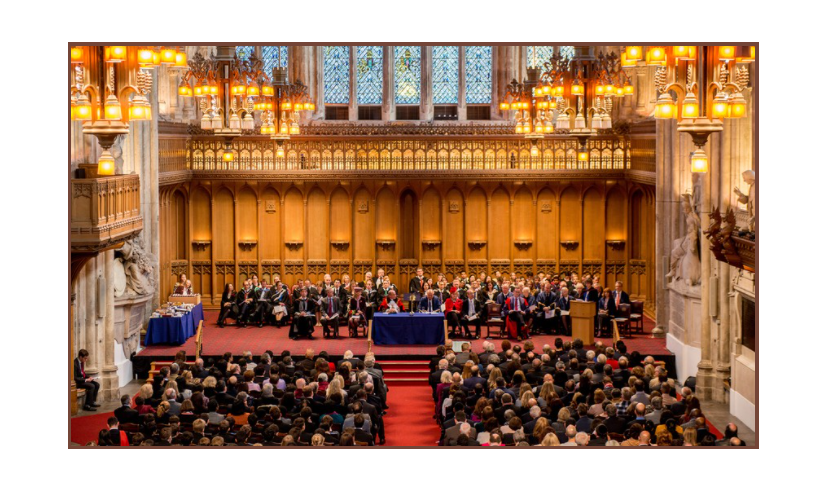
You may think that local government in Great Britain is both boring and easy to understand. A resident has a vote, the candidate who wins the most votes represents an area – called a ward – on the council, and councillors debate stuff and make decisions <yawn>. Well, prepare to have your preconceptions blown away as I take you on a journey into the bizarre world of the City of London.
Let me begin with a history lesson. The earliest significant settlement in the area was Roman Londinium, on the site of what we now call the ‘Square Mile’ or ‘the City’. This was protected by a large defensive wall. After the Romans departed c.400, incoming Anglo-Saxons didn’t like the look of Londinium and instead set up Lundenwic a few hundred metres to the west, near modern-day Aldwych. To this day, Aldwych is known for having no defensive features whatsoever; when Vikings came a-pillaging, such anti-social behaviour was not easily repelled. Thus, in 886, the Anglo-Saxons led by Alfred the Great did a complete volte-face, retreating to the safety of Londinium where they then stayed. A municipal authority emerged through the later Anglo-Saxon and early medieval period, an authority that amazingly is still with us today. It is now called the Corporation of the City of London (‘the Corporation’).
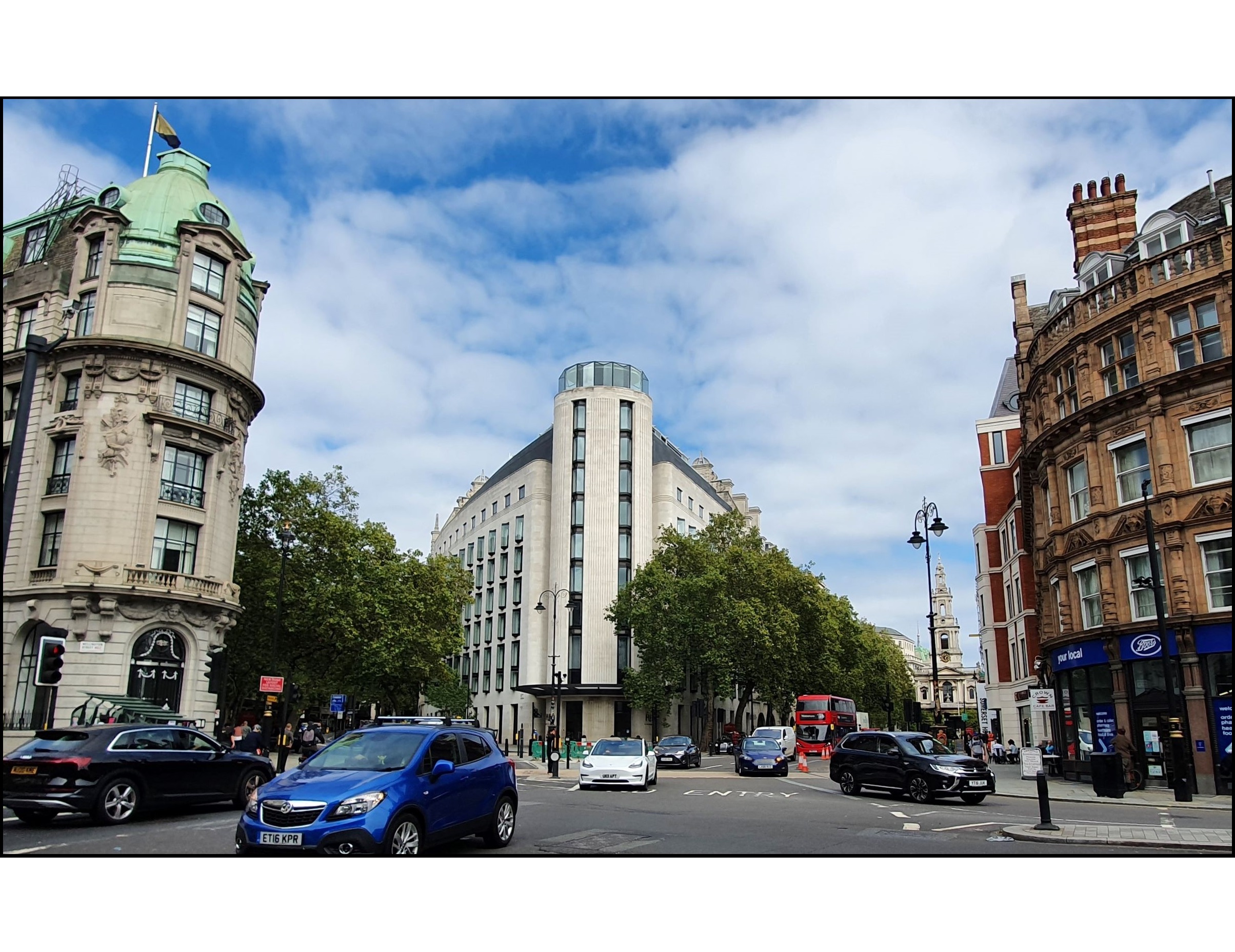
→ Easy pickings for marauding Vikings. The name Aldwych, meaning ‘old village’, has only been used since a major redevelopment c.1900, but harks back to Anglo-Saxon times, inspired by a long-demolished road called Wych Street.
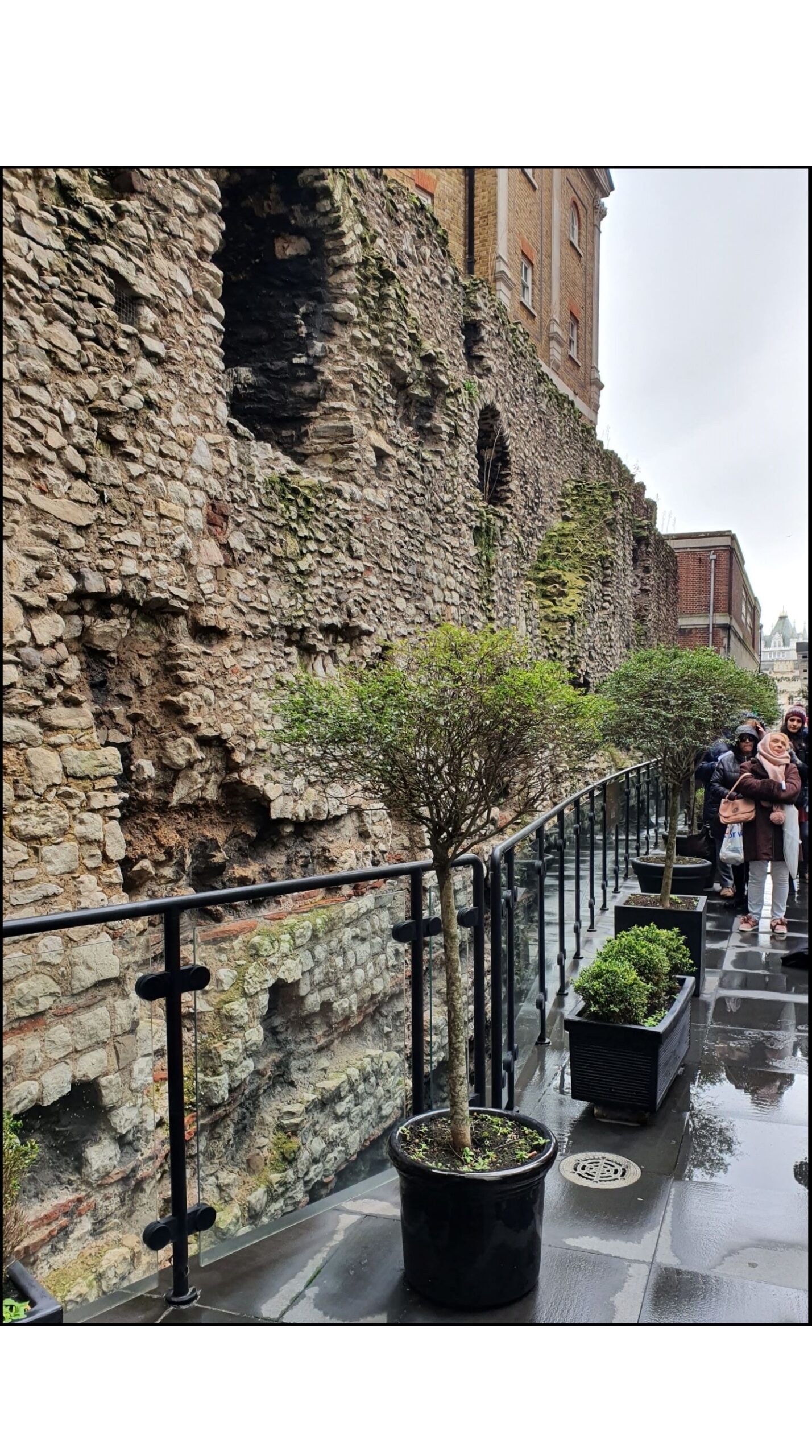
← A surviving part of the Viking-proof London Wall near the Tower of London. The lower sections, with layers of red tiles just visible, are Roman. Higher levels in this section are mostly medieval.
The town on the site of Londinium was such a success that the population grew significantly through the following centuries. Eventually, things got so cramped within the protective walls that some people, preferring not to play a game of ‘sardines’ 24/7, began to live outside them in adjoining lands that were part of counties like Surrey and Middlesex. This process accelerated dramatically in the 18th and 19th centuries.
But as London grew, the area controlled by the Corporation didn’t, save for the acquisition of a few acres of land immediately adjacent to the walls. Its domain remained confined to the Square Mile. In fact, it didn’t – and still doesn’t – include the whole of the Square Mile. The Middle and Inner Temples, two of the four Inns of Court where lawyers train and practice, are within the City but beyond the control of the Corporation. However, as they are run by lawyers, I won’t try to explain how these weird anomalies function, as I may get sued. Best you forget I mentioned them, and particularly that I just called them weird anomalies.
By the mid-19th century there was a growing belief that what was now a vast metropolis needed a single governing body. The urban areas previously in other counties finally became London Boroughs in 1900, with their own borough councils, and a coordinating role was given to a regional authority from 1889, at various times called the LCC, the GLC and today the Greater London Authority (‘GLA’). The area controlled by this regional authority, known as the ceremonial county of Greater London, and the structure of both the authority and the London Boroughs, have evolved considerably over time.
The Corporation had refused to be part of the reorganisation, so the Square Mile is not a London Borough and is not controlled by the GLA. Unfortunately for the fiercely independent Corporation, from the early 19th century the population of the Square Mile had been declining, as people moved to leafy suburbs or cheaper urban areas. The process accelerated in WW2 to the point where just 6,000 people lived within the Corporation’s boundaries in 1950. Even today, with modern residential developments like the Barbican, this global financial powerhouse that governs itself, and even controls its own police force, has a population of only 9,500 – the size of a small town.
Next, I’ll describe the structure of the Corporation, an organisation older than the Parliament at Westminster, and housed at the Guildhall since 1411. There are two main bodies, the Court of Common Council and the Court of Aldermen. Voters in each of twenty-five wards elect between two and eight councilmen, depending on the number of voters, and one alderman. The Court of Common Council is the new kid on the block, being only 644 years old. It has the most power, but meets just once every four weeks, as much of the work is done by committees – I counted 100 committees, sub-committees, consultative committees and working parties on the Corporation’s website. Councilmen serve for a term of four years. The more senior Court of Aldermen, in existence since Anglo-Saxon times, is nowadays more ceremonial, although it has a key role in selecting senior officials and most Aldermen sit as magistrates and serve on committees. They also look after Epping Forest, because someone has to. Aldermen serve for six years.
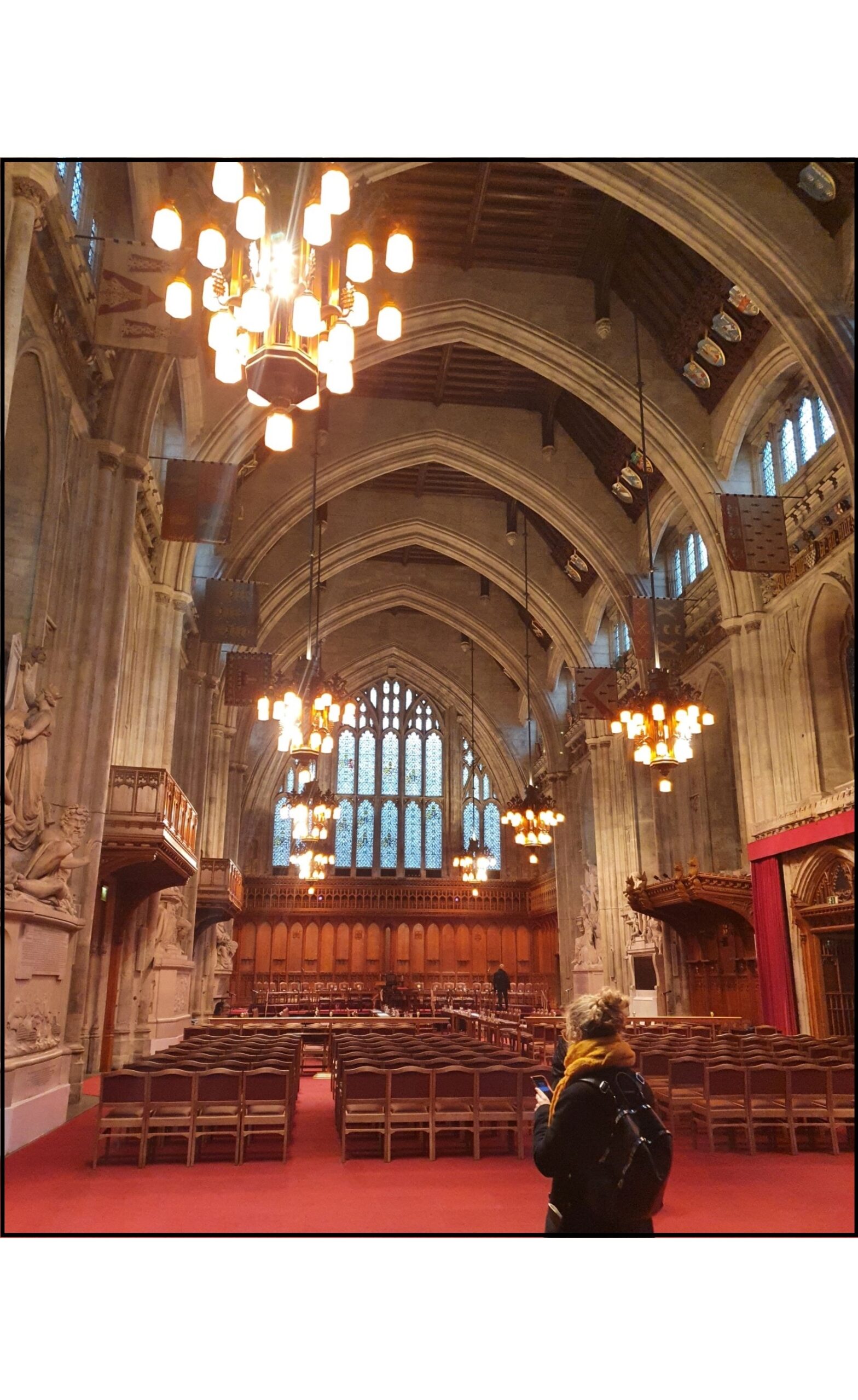
→The interior of the Guildhall, the second largest medieval hall in the metropolis, and the seat of power of the Corporation. It dates from 1411, although decorators have had to be called in on several occasions – most notably after damage suffered during some local difficulties in 1666 and 1940.
Senior to the Court of Aldermen are two Sheriffs, who live at the Central Criminal Court, aka the Old Bailey – and whose positions are believed to date from the 7th century. Above the Sheriffs, looking down on all he – or very occasionally, she – surveys is the Lord Mayor, a position created in 1189. Sheriffs and Lord Mayors usually serve for only one year, and are not elected by the ward electorate. More on this anon.
Ward boundaries get revised very, very occasionally. You may think this would be done by the independent Boundary Commission – upholders of all that is fair and balanced in defining British political boundaries. Well stop thinking that, because the Corporation does things differently. Boundary revisions are instead decided by officials of the Corporation and judges at the Old Bailey.

← The wards of the Square Mile. This particular structure applied from 2003 until some very minor adjustments to boundaries were made in 2013.
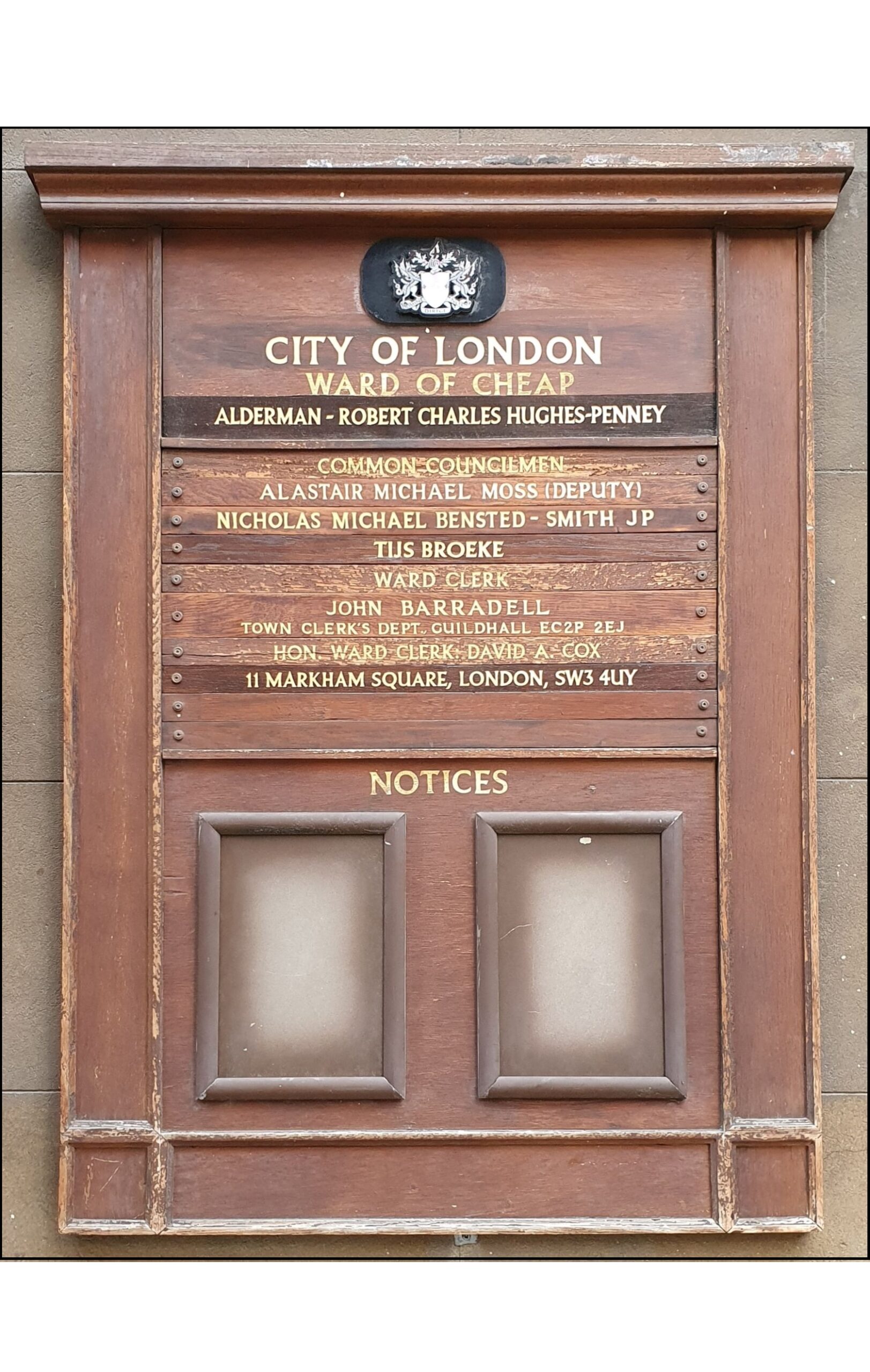
→ Signs like this appear in each ward. Cheap, based around the medieval City ‘High Street’ of Cheapside, in the very centre of the map above, is one of the smaller wards – it elects only three Councilmen. Despite the gender-specific titles, both Councilmen and Aldermen can be women.
Returning to weird anomalies, the ward of Bridge Without is an absolute corker. The Corporation created it in 1550, out of land in Southwark it had bought from the King. Its aim was to stop criminals escaping City justice by the clever stratagem of walking across London Bridge into Southwark. No-one in Bridge Without ever got to vote in City elections; the ward had no Councilmen. It did have an Alderman, but the Court of Aldermen appointed him themselves. This strange state of affairs continued until the ward was abolished in 1978, by which time it was probably too much of an eccentricity. Southwark had become a London Borough in 1900, so Bridge Without no longer needed the democratic representation at Guildhall it hadn’t had for 428 years.
Finally, I’ll explain who can vote, who can stand, and how Sheriffs and Lord Mayors are elected. You may think the election of Councilmen and Aldermen is by one-resident-one-vote. Oh dear me no. Recall the tiny residential population, which may have different priorities to the multinational financial institutions and other organisations based within the City boundaries that effectively pay the City’s bills. The solution is for those organisations to nominate additional electors. The formula for determining the number of nominations has changed over time; currently a company with ten employees nominates one voter, with numbers increasing on a sliding scale up to companies with a thousand or more employees, which nominate twenty-nine. Nominated electors outnumber residential electors three-to-one.
Those wishing to stand for election as Councilmen must, among other more predictable conditions, be a Freeman of the City. So how exactly does one become a Freeman? A person can only do so through membership of a livery company or by application supported by an appropriate proposer and seconder. Without business, administration or family connections to a livery company or the City administration, or a lot of money, this is unlikely to happen. Those wishing to stand for Alderman must, in addition, be either a qualified Justice of the Peace or – a recent option, this – have no convictions for imprisonable offences.
I should at this point explain what a livery company is. In brief, they are trade guilds that evolved in the medieval period to regulate and protect their trade within the City, becoming immensely powerful in the process. They still exist, wrapped up in ancient tradition and ceremony, although some of their trades don’t – when was the last time you met a tallow chandler – and they are now more charitable and educational institutions than trade guilds. Some, like the Worshipful Company of Mercers, are immensely wealthy, with grand livery halls. Others have little money and often rent space from their wealthier siblings. Modern professions – such as ‘Information Technologists’, as they are known in the City for some reason – are allowed to form new guilds.
Traditionally, those seeking election in the City stand as independents – that is, without a declared affiliation to a political party. However, in recent years the local Labour Party, frustrated at a perceived slow pace of reform, has started nominating candidates for the Court of Common Council. As a result, there are currently five Labour Councilmen and ninety-five independents.
Unlike Councilmen and Aldermen, the Sheriffs and Lord Mayor are elected by a ‘Common Hall’ – an assembly of liverymen. Liverymen are senior members of the livery companies. But is a Common Hall truly an election? Well, rarely. The Livery Committee website, designed to offer guidance to livery company clerks, rather gives the game away when describing the historical context of these elections, recalling a time ‘… when these things really mattered, and there was a real election for Lord Mayor and Sheriffs …’. What actually happens is that the Aldermen decide behind closed doors, through a selection panel and perhaps involving masters of some livery companies, who to nominate as Lord Mayor and one or both of the Sheriffs. The Aldermen then tell the livery companies who their choices are.
I say one or both Sheriffs because, by tradition, at least one of the elected Sheriffs must be an existing Alderman – an ‘aldermanic Sheriff’ – but one might not be enough. This is because the Lord Mayor must be an Alderman and an existing or previous Sheriff, leading to a rather restricted list of potential Mayoral candidates. If there looks to be an impending shortage, both Sheriffs may be ‘aldermanic’ to boost future numbers.
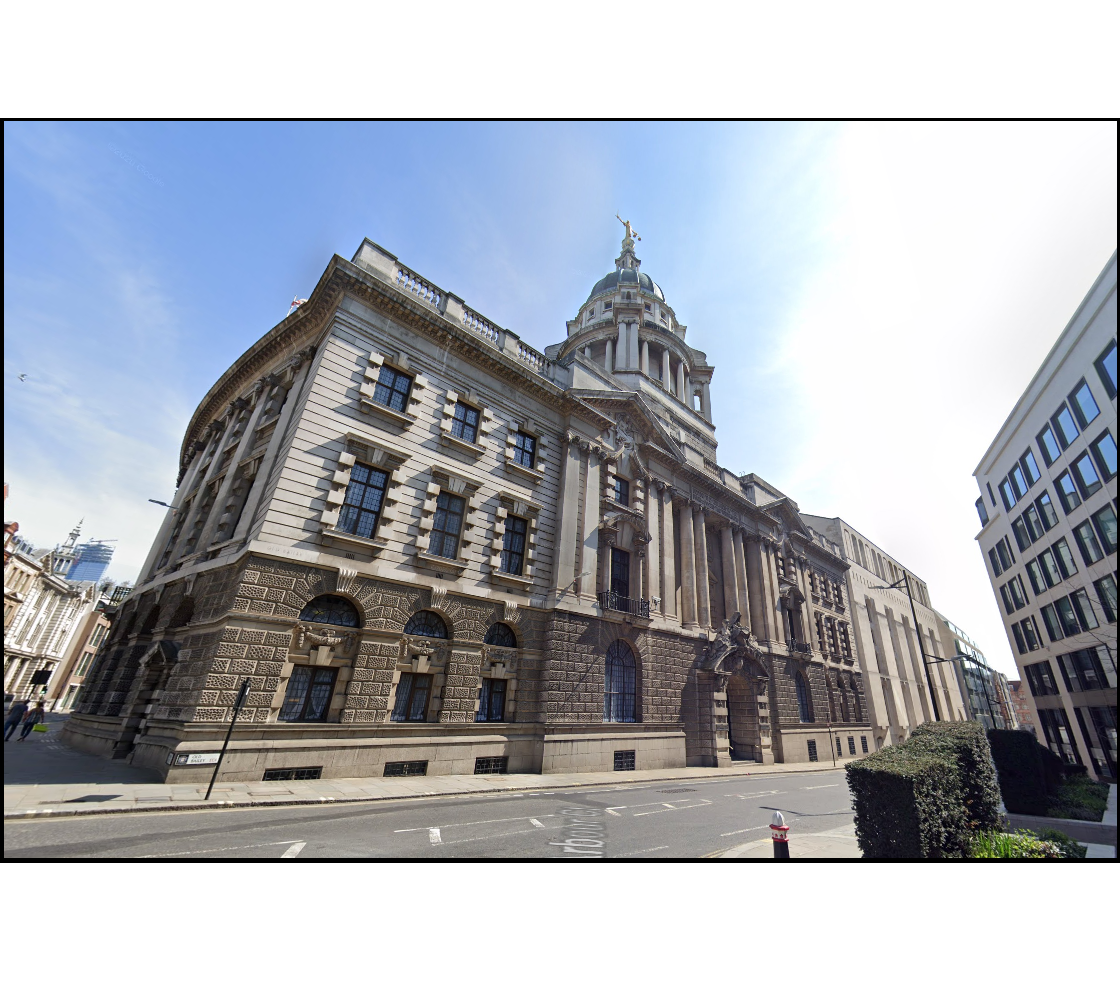
← A des. res. for Sheriffs: The Old Bailey, named after the road in which it stands. Elected Sheriffs live here for their term of office.
Liverymen have two votes for Sheriff and traditionally, any non-aldermanic Sheriff candidates ask supporters to use the second vote for the aldermanic candidate. So, the aldermanic candidate is a shoo-in. However, the election of the non-aldermanic Sheriff, if there is an opening, can be contested.
The Mayoral candidate is likewise an uncontested shoo-in. The elected Lord Mayor doesn’t get any additional pay – so private income seems essential – but does get a parade, palatial accommodation called the Mansion House, and travels the world as an ambassador for the City. In 2020, in competition with a woman and a gay man, a heterosexual male got the job. All three candidates were white. This is no surprise – diversity is not a word that springs to mind when looking at past Lord Mayors: Out of 680, there have been two women, one man who was 1/8 a person of colour – James Townsend, Lord Mayor in 1772/3, although his antecedents probably weren’t widely known at the time – and one future pantomime hero.
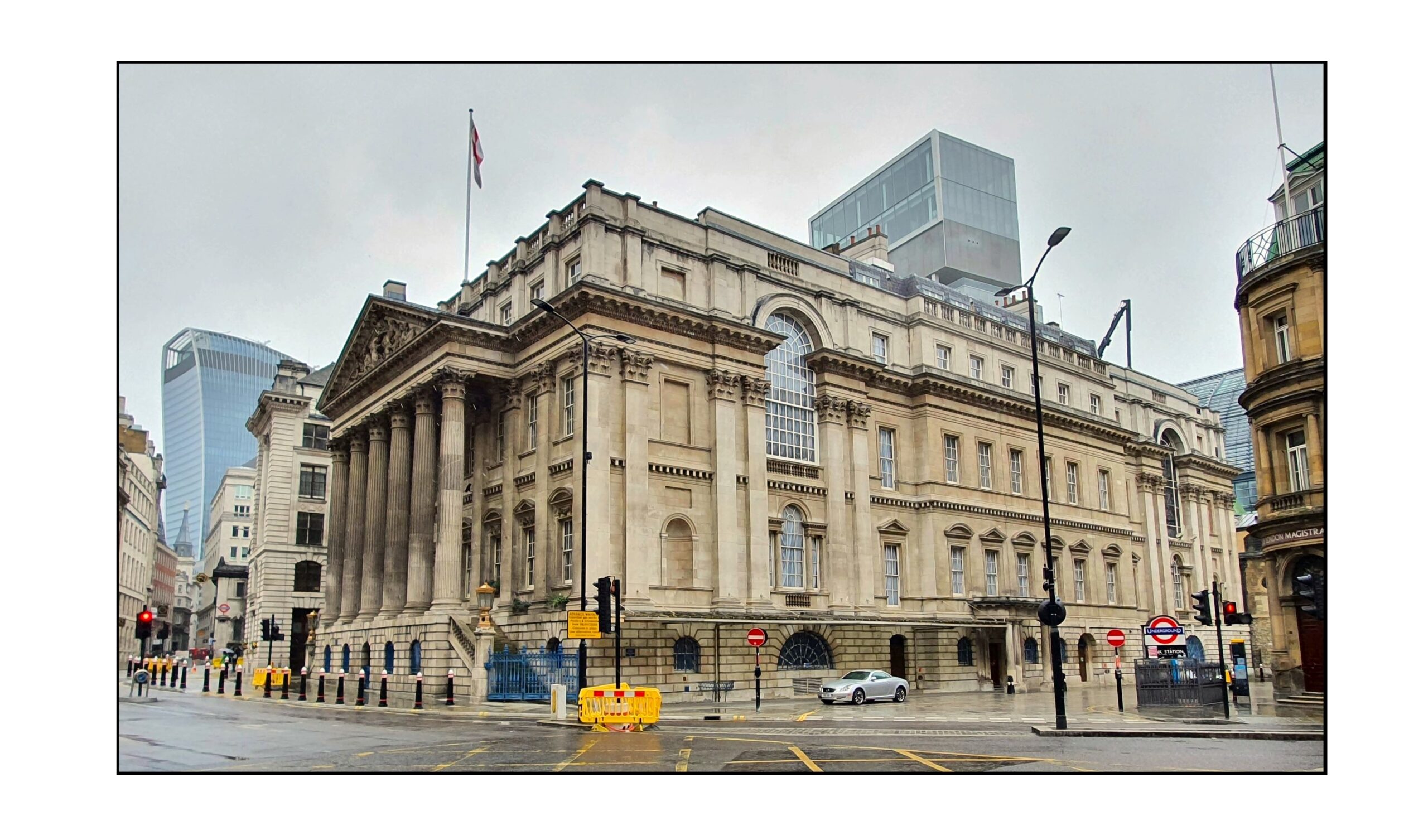
→ A des. res. for Lord Mayors: The Mansion House, close to the Bank of England and the Royal Exchange.
Unsurprisingly, the Mayoral selection process has come in for criticism in recent years, with City AM, the morning financial paper of the Square Mile, describing it as ‘opaque, … remaining largely unchanged for nearly 800 years’ and suggesting it was a process run by Guildhall heavyweights behind closed doors. With its overwhelmingly white male heterosexual upper-middle class appearance, the Corporation seems to be out of step with the times and perhaps is beginning to realise that. There seems to be a small but genuine agitation for change from within, and it must be possible to strike a balance between modernisation and tradition satisfactory to most stakeholders. I just wouldn’t expect it to happen overnight – particularly as it would, of necessity, involve the livery companies as well. We’re talking slow evolution, not revolution.
Nearest Stations:
Credits:
Selected Bibliography:
1 thought on “Local Government, City of London Style”
Comments are closed.